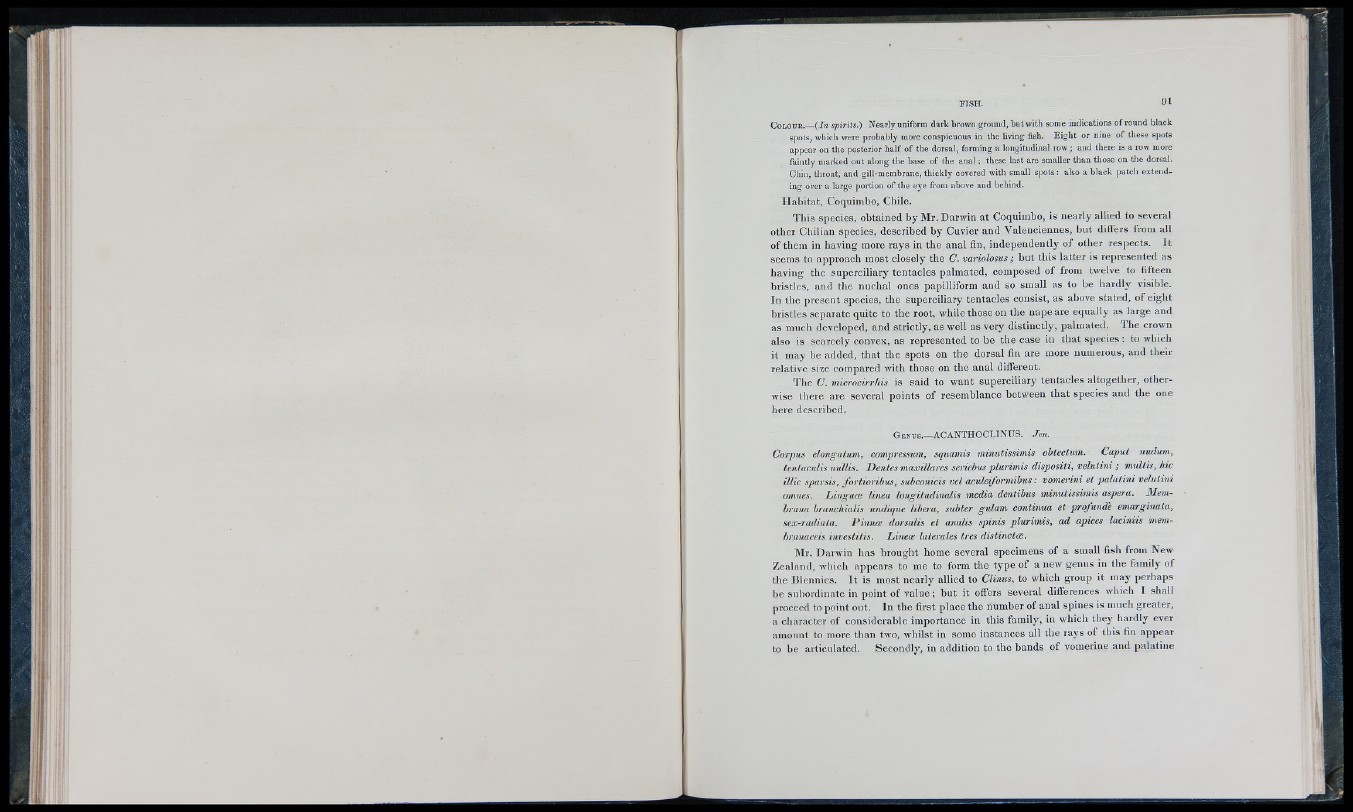
C o lo u r.—(Jra spirits.) Nearly uniform dark brown ground, but with some indications of round black
spots, which were probably more conspicuous in the living fish. E igh t or nine of these spots
appear on the posterior h alf of the dorsal, forming a longitudinal row ; and there is a row more
faintly marked out along the base of the a n a l; these last are smaller than those on the dorsal.
Chin, throat, and gill-membrane, thickly covered with small spo ts: also a black patch extending
over a large portion of the eye from above and behind.
H abitat, Coquimbo, Chile.
This species, obtained by M r. Darwin at Coquimbo, is nearly allied to several
other Chilian species, described by Cuvier and Valenciennes, but differs from all
of them in having more rays in the anal fin, independently of other respects. It
seems to approach most closely the C. variolosus; but this latter is represented as
having the superciliary tentacles palmated, composed of from twelve to fifteen
bristles, and the nuchal ones papilliform and so small as to be hardly visible.
In the present species, the superciliary tentacles consist, as above stated, of eight
bristles separate quite to the root, while those on the nape are equally as large and
as much developed, and strictly, as well as very distinctly, palmated. The crown
also is scarcely convex, as represented to be the case in that species: to which
it may be added, that the spots on the dorsal fin are more numerous, and their
relative size compared with those on the anal different.
The C. microcirrhis is said to want superciliary tentacles altogether, otherwise
there are several points of I’esemblance between that species and the one
here described.
G e n u s .— A C A N TH O C LIN U S. Jen.
Corpus eìoìigaium, compressum, squamis minutissimis ohtectum. Caput nudum,
tentaculis nullis. Denies maxillares seriebus plurimis dispositi, velutini ; mxdtis, hie
illic sparsis, fortioribus, subconicis vel aculeiformibxis : vomerini et palatini velutini
omnes. Linguce linea longitudinalis media dentibus minutissimis aspera. 3Iem-
hrana hranchialis xindique libera, subter guJani continua et profundh emarginata,
sex-radiata. P innx dorsalis et analis spinis plurimis, ad apices laciniis mem-
hranaceis investitis. L inex laterales tres distinctcs.
]Mr. Darwin lias brought home several specimens of a small fish from New
Zealand, which appears to me to form the type of a new genus in the family of
the Blennies. It is most nearly allied to Clinus, to which group it may perhaps
be subordinate in point of value ; but it oflers several differences which I shall
proceed to point out. In tlie first place the number of anal spines is much greater,
a character of considerable importance in this family, in which they hardly ever
amount to more than two, whilst in some instances all the rays of this fin appear
to be articulated. Secondly, in addition to the bands of vomerine and palatine